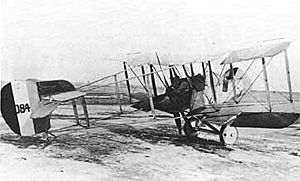Patrick Anthony Langan-Byrne facts for kids
Quick facts for kids
Patrick Anthony Langan Byrne
|
|
|---|---|
| Born | 1895 Clogherhead, County Louth, Ireland, United Kingdom |
| Died | 16 October 1916 (aged 20–21) |
| Commemorated at |
Arras Flying Services Memorial, Pas de Calais, France
|
| Allegiance | |
| Service/ |
British Army |
| Years of service | 1914–1916 |
| Rank | Second Lieutenant |
| Unit | 30th Brigade, RFA No. 24 Squadron RFC |
| Battles/wars | World War I • Western Front |
| Awards | Distinguished Service Order |
Second Lieutenant Patrick Anthony Langan Byrne (1895 – 16 October 1916) was a brave Irish pilot during World War I. He was known as a "flying ace" because he shot down ten enemy aircraft. He served in the British Army.
Contents
Early Life
Patrick Byrne was born in 1895 in a place called Clogherhead in County Louth, Ireland. His parents were Dr. and Mrs. J. V. Byrne. He went to school at Clongowes.
Patrick Byrne in World War I
World War I was a very big war that lasted from 1914 to 1918. Patrick Byrne joined the army on 9 October 1914. He first served in the Royal Field Artillery. This part of the army used large guns called howitzers.
Later, he joined the Royal Flying Corps on 4 August 1916. This was the air force of the British Army at the time. He became a flying officer, meaning he flew airplanes.
Becoming a Flying Ace
Patrick Byrne became a "flying ace." This is a special title given to pilots who shoot down five or more enemy aircraft. He flew an Airco DH.2 plane. This type of plane was used for all his victories.
He got his first victory on 31 August 1916. He made an enemy plane land. Three days later, he made another German plane go out of control. On 15 September, he shot down a German fighter plane, and it caught fire. The next day, he destroyed a Fokker D.II plane.
Between 21 and 28 September, he forced five more enemy planes to land. Even when four German planes shot at him on 23 September, it didn't stop him.
His Last Flight
On 14 October, Patrick Byrne was promoted to a temporary captain. He had his last victory on the morning of 16 October. Later that same day, he went on another flight. He led his group of planes toward a famous German pilot named Oswald Boelcke.
Sadly, Oswald Boelcke shot down Patrick Byrne's plane. This was Boelcke's 34th victory. Patrick Byrne's grave is not known, but it is believed he was buried. His commanding officer, Major Lanoe Hawker, said he was "a nice lad" and "the best officer."
Because he died in World War I and his grave is unknown, he is remembered at the Arras Flying Services Memorial in France. Patrick Byrne was the most successful pilot to fly the Airco DH.2 plane. He achieved all 10 of his victories in this type of aircraft.
Patrick Byrne's Victories
Here is a list of the enemy planes Patrick Byrne shot down or forced to land:
| No. | Date/Time | Aircraft/ Serial No. |
Opponent | Result | Location |
|---|---|---|---|---|---|
| 1 | 31 August 1916 @ c.1800 |
DH.2 (6010) |
Enemy aircraft | Forced to land | North of Bapaume |
| 2 | 2 September 1916 @ 1935 |
DH.2 (6010) |
Single-seat fighter | Out of control | Beaulencourt |
| 3 | 15 September 1916 @ 0830 |
DH.2 (7911) |
Single-seat fighter | Destroyed in flames | North-east of Morval |
| 4 | 16 September 1916 @ 1900 |
DH.2 (7911) |
Fokker D.II | Destroyed | Achiet |
| 5 | 21 September 1916 @ 1745 |
DH.2 (7911) |
LVG two-seater | Forced to land | North of Miraumont |
| 6 | 22 September 1916 @ 1140 |
DH.2 (7911) |
Enemy aircraft | Forced to land | Vélu |
| 7 | 22 September 1916 @ 1800 |
DH.2 (7911) |
Rumpler two-seater | Forced to land | Grandcourt |
| 8 | 23 September 1916 @ 0815 |
DH.2 (7911) |
Rumpler two-seater | Forced to land | East of Combles |
| 9 | 28 September 1916 @ 1710 |
DH.2 (A2538) |
LVG two-seater | Forced to land | Rocquigny |
| 10 | 16 October 1916 @ 1030 |
DH.2 (5925) |
Albatros D.I | Forced to land | Biefvillers |
Awards and Recognition
Patrick Byrne received a special award called the Distinguished Service Order. This award is given for great bravery and skill.
His award citation said: "For his amazing skill and bravery. He showed great courage in attacking enemy planes, even when there were many more of them. He took down several. One time, with two other planes, he attacked seventeen enemy planes. He shot one down in flames and forced another to land."


